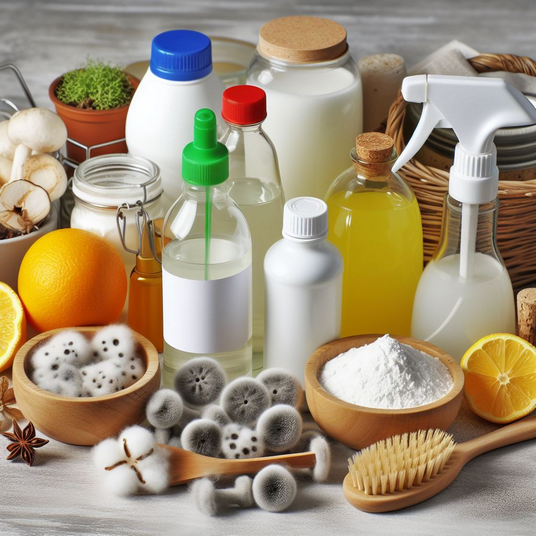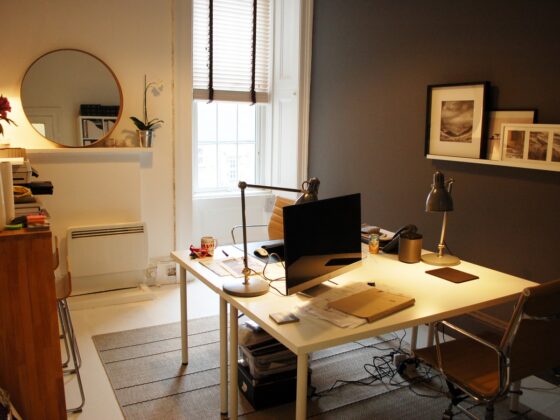Yes, you read that right – vinegar is the magic ingredient for killing and cleaning household mould. This humble pantry staple has been used for centuries for its powerful cleaning properties, and it turns out that it is just as effective when it comes to tackling mould.
So, how does vinegar work its magic on mould? Well, it all comes down to its acidic nature. Vinegar is a natural acid, specifically acetic acid, which makes it a potent antimicrobial agent. When applied to mould, vinegar breaks down the mould’s structure and kills it at the root.
But vinegar doesn’t just kill mould; it also helps to clean and remove the unsightly stains left behind. Its acidic properties dissolve the mould spores, making it easier to scrub away the residue. Plus, vinegar is a natural deodorizer, so it can help eliminate any musty odours that mould may have left behind.
When using vinegar to tackle mould, it’s important to use it undiluted for maximum effectiveness. Simply pour the vinegar into a spray bottle and apply it directly to the affected areas. Let it sit for a few minutes to allow the vinegar to penetrate the mould, then scrub the area with a brush or sponge. Rinse with water and repeat the process if necessary.
While vinegar is a powerful mould killer, it’s important to note that it may not be suitable for all types of surfaces. For example, vinegar is acidic and can damage certain materials like marble or stone. It’s always a good idea to test a small, inconspicuous area before using vinegar on delicate surfaces.
So, the next time you find yourself faced with mould in your home, don’t reach for harsh chemicals or expensive cleaning products. Instead, head to your kitchen pantry and grab a bottle of vinegar. Not only will it save you money, but it will also help you tackle mould in an eco-friendly and effective way.

Why Vinegar?
Vinegar has been used for centuries for its cleaning and disinfecting properties. It is a natural, non-toxic, and affordable solution that can effectively kill mould and prevent its growth. Here are a few reasons why vinegar is the perfect ingredient for tackling household mould:
- It’s a powerful disinfectant: Vinegar has antimicrobial properties that can kill a wide range of bacteria, viruses, and fungi, including mould. This makes it an excellent choice for cleaning and sanitizing various surfaces in your home.
- It’s safe to use: Unlike harsh chemical cleaners, vinegar is non-toxic and safe to use around children and pets. You don’t have to worry about harmful fumes or residues left behind.
- It’s readily available: Vinegar is a staple in most kitchens, making it easily accessible whenever you need it. You don’t have to spend a fortune on expensive cleaning products.
- It’s environmentally friendly: Choosing vinegar as a cleaning agent helps reduce your environmental impact. It is biodegradable and doesn’t contribute to water pollution like some chemical cleaners do.
When it comes to mould removal, vinegar is a versatile and effective solution. Its acidic nature helps break down the mould’s structure and kill it at the source. Whether you’re dealing with mould on bathroom tiles, kitchen countertops, or even fabrics, vinegar can be used in various ways to eliminate the problem.
For surface mould, you can create a simple vinegar solution by mixing equal parts of vinegar and water in a spray bottle. Spray the solution onto the affected area and let it sit for a few minutes. Then, scrub the area with a brush or sponge to remove the mould. Rinse the surface with water and dry thoroughly.
If you’re dealing with stubborn mould stains on fabrics, such as curtains or upholstery, you can add a cup of vinegar to your washing machine along with your regular detergent. Run the cycle as usual, and the vinegar will help kill the mould and remove any lingering odours.
It’s important to note that while vinegar is effective in killing mould, it may not be suitable for all surfaces. It is best to test a small, inconspicuous area first to ensure that vinegar does not cause any damage or discolouration. Additionally, vinegar may not be as effective on porous surfaces, such as wood or drywall, where mould can penetrate deeper.
In conclusion, vinegar is a versatile and affordable solution for tackling household mould. Its disinfecting properties, safety, accessibility, and environmental friendliness make it a popular choice among homeowners. Whether you’re dealing with surface mould or stubborn stains on fabrics, vinegar can be a powerful ally in your battle against mould.
Preventing Mold Growth
Now that you’ve successfully killed and cleaned the mould using vinegar, it’s important to take preventive measures to ensure it doesn’t come back. Here are some tips:
- Keep your home well-ventilated: Proper air circulation helps prevent moisture buildup, which is a breeding ground for mould. Open windows, use exhaust fans or invest in a dehumidifier to maintain optimal humidity levels.
- Fix any leaks: Leaky pipes, roofs, or windows can create damp areas where mould can thrive. Regularly inspect your home for any signs of leaks and address them promptly.
- Control humidity levels: Aim to keep indoor humidity levels between 30-50%. Use air conditioners or dehumidifiers in humid areas or during humid seasons to maintain a dry environment.
- Remove excess moisture: After showering or cooking, wipe down surfaces and dry any wet areas immediately. Don’t leave damp towels or clothes lying around, as they can contribute to mould growth.
- Use mould-resistant products: When renovating or redecorating, opt for mould-resistant materials such as mould-resistant drywall, paint, and flooring. These products have additives that inhibit mould growth.
- Regularly clean and inspect: Routinely clean and inspect areas prone to mould, such as bathrooms, basements, and attics. Regular maintenance and early detection can prevent mould from spreading and causing extensive damage.
By following these preventive measures, you can minimize the chances of mould returning and keep your home clean and mould-free.
Additional Tips and Precautions
While vinegar is a powerful mold-killing ingredient, there are a few additional tips and precautions you should keep in mind:
- Test on a small area first: Before applying vinegar to a larger mould-infested area, test it on a small, inconspicuous spot to ensure it doesn’t damage the surface. This is especially important if you are dealing with delicate materials such as antique furniture or delicate fabrics.
- Use vinegar on non-porous surfaces: Vinegar is most effective on non-porous surfaces like tiles, glass, and countertops. These surfaces are less likely to absorb the vinegar, allowing it to fully penetrate and kill the mould. However, if you have mould on porous materials such as upholstery or carpets, it is best to consult a professional mould remediation specialist.
- Don’t mix vinegar with bleach: While vinegar is safe to use alone, never mix it with bleach or other cleaning products containing chlorine. This combination can create toxic fumes that can be harmful if inhaled. It is always best to stick to one cleaning product at a time and avoid mixing chemicals unless specifically instructed to do so by a professional.
- Prevent future mould growth: To prevent mould from returning, it is important to address any underlying moisture issues in your home. Fixing leaks, improving ventilation, and keeping humidity levels in check are all crucial steps in preventing mould growth. Additionally, regularly cleaning and drying areas prone to moisture, such as bathrooms and basements, can help keep mould at bay.
- Consider using protective gear: When dealing with mould, it is advisable to wear protective gear such as gloves, goggles, and a mask to prevent direct contact with mould spores and minimize the risk of respiratory issues. This is particularly important if you have a mould allergy or pre-existing respiratory conditions.
Conclusion
Highlights the effectiveness of baking soda as a non-toxic, eco-friendly solution for combating household mould. Baking soda’s alkaline nature disrupts the acidic environment mould thrives, while its absorbent properties help remove moisture that mould needs to grow. Additionally, its mild abrasiveness allows it to clean mould from porous surfaces and neutralize odours. For a potent mould-fighting paste, one can mix baking soda with water and optionally add vinegar for extra strength, applying it to the affected areas and letting it sit before scrubbing off. This simple kitchen ingredient thus proves to be a powerful ally in maintaining a clean and healthy home environment.
Frequently Asked Questions
Yes, baking soda can effectively remove mould. It has mild abrasive properties that help scrub away surface mould and absorb moisture, which is crucial for preventing mould growth.
While baking soda is non-toxic and safe for household use, it’s still recommended to wear gloves and a mask to avoid inhaling any mould spores during the cleaning process.
Baking soda is versatile and can be used on most surfaces, including hard surfaces like tile and softer surfaces like upholstery. However, always do a spot test first to ensure it doesn’t damage the material.
The smell of vinegar will dissipate after cleaning. To help neutralize the odour, you can rinse the area with water and let it air out.
Typically, you’ll need a tablespoon of baking soda for every cup of water. This ratio can be adjusted depending on the amount of solution needed. Apply the solution to the mouldy area and scrub.












4 comments
You’re welcome! I appreciate your willingness to engage further. If you have any specific questions or topics you’d like to delve into, feel free to share them. Whether it’s about recent developments in technology, intriguing scientific discoveries, captivating literature, or anything else on your mind, I’m here to provide insights and assistance. Simply let me know how I can help, and I’ll be happy to assist you further!
I loved as much as youll receive carried out right here The sketch is tasteful your authored material stylish nonetheless you command get bought an nervousness over that you wish be delivering the following unwell unquestionably come more formerly again since exactly the same nearly a lot often inside case you shield this hike
I have been surfing online more than 3 hours today yet I never found any interesting article like yours It is pretty worth enough for me In my opinion if all web owners and bloggers made good content as you did the web will be much more useful than ever before
Hi i think that i saw you visited my web site thus i came to Return the favore Im attempting to find things to enhance my siteI suppose its ok to use a few of your ideas